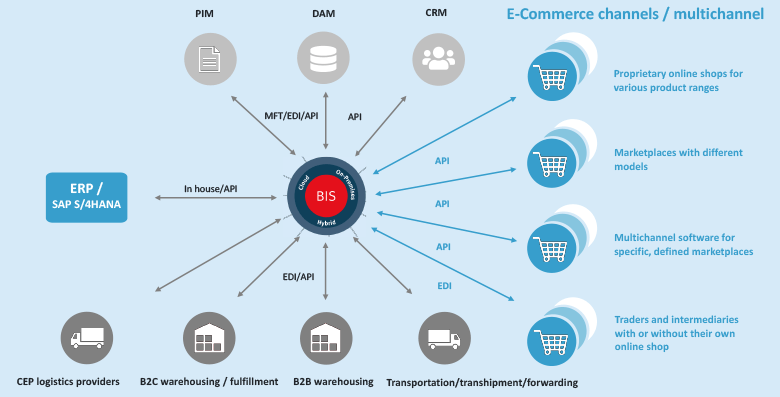
There are many good reasons for following a multichannel strategy. You may be starting out with e-commerce or wanting to increase brand awareness. Maybe you are entering new markets, or wanting to gather customer information to optimize future sales activities and product development. In most cases, following a multichannel strategy is a compelling way to enable a multi-faceted customer journey, which drives revenues and often leads to your own online shop.
The challenges of a multichannel strategy
Unfortunately, pretty much everything about this business model is complex and full of challenges. Nevertheless, online marketplaces are springing up like mushrooms. Retailers and manufacturers alike are striving not only to find the right ones, but also ways and means to connect to them quickly, flexibly and efficiently.
What these marketplaces need to do is legion, while what they can do is difficult to compare. However, three key areas are listing, warehousing and logistics. If you (regularly) use these services alongside your own shops and distributors, you need to ensure, monitor and control up-to-date data flows from price, product and merchandise management systems. This is critical to ensure that your presence on all these marketplaces benefits your company. However, it would be very difficult to orchestrate this manually.
An integration platform is the foundation for a technical infrastructure that would let you agilely react to and automate current and future business needs.
Multichannel integration
Carefully considering your product range, sectors and countries, you need to define what strategy your marketplace will follow. And, if choosing sales platforms and regions were not difficult enough, you are now faced with a whole bouquet of further colourful integration challenges.
Although your long-standing ERP system has been tailored to decades of B2B business, it is now pretty obsolete. E-commerce requires new interfaces, more modern integration technologies and a host of additional processes. Marketplaces work with different data formats, partly because they require real-time communication and direct access to specialist business applications and partners.
The complexity of multichannel business
As you can imagine, using multichannel software to connect multiple channels is complex. However, PIM and DAM systems and services provide product details and images that a potential buyer needs to confidently make a purchase. Warehousing and logistics providers’ systems supply information on stock levels and delivery periods. An ERP system may contain different prices for certain marketplaces, your own shop, and drawing on the CRM system, even for specific customer groups. All this data must be synchronised in an event-based manner, and the processes behind this automated. Only in this way can you provide reliable information on every channel, quickly fulfil orders, optimally use stock and efficiently handle returns, while avoiding costly manual updates and maintenance.
Multichannel software promises to connect many marketplaces at once. However, you also need interfaces to important IT systems and partners. To this end, if your multichannel software does not have built-in connections to your intended markets, it’s more a hindrance than a help.
 Image: The SEEBURGER BIS integrates marketplaces, online shops, trading partners and their systems and other services.
Image: The SEEBURGER BIS integrates marketplaces, online shops, trading partners and their systems and other services.Once we start looking at the individual tasks in marketplace trading more closely, we start to really see its complexity. There are countless possibilities depending on cost, specifications or overall concept.
Automate multichannel sales processes with an integration platform
Traders and manufacturers regularly discover that there isn’t an off-the-shelf option that is an exact fit for their intended strategy. If you are also affected by this common occurence, it’s well worth searching for a partner like SEEBURGER, who can set up, manage and monitor the technologies you need for your e-commerce strategy, flexibly, efficiently, digital and automated, when and how you need them. This may include the approaches and integration scenarios listed below.
a) Options for being listed on marketplaces
- Use BIS to create an ERP catalogue data feed through B2B/EDI mappings, or cloud-based integration using PRICAT. Can be supplemented by CSV and image files uploaded using MFT.
- Use BIS to integrate catalogue data with APIs, with automated APIs for price information, stock levels and delivery.
- Use a content service provider to prepare your data and list you on various marketplaces. Securely transfer the large data volumes they need through BIS.
- Listing as a paid marketplace service, potentially including content creation and marketing measures. This often involves a PRICAT data feed alongside transfer of comprehensive catalogue data for programme management using BIS MFT capabilities.
- Use multichannel software which offers built-in listing functionality, often includes order processing and sometimes includes an interface to your own online shop and some ERP integration. Use BIS to process and transfer data between service providers and the back end.
- Wholesalers who manage listing, order processing, and maybe warehousing on your behalf. (Enable data flow through BIS‘s B2B/EDI data transfer capabilities, potentially also harnessing BIS’s API integration capabilities to connect up intermediaries.
- Localized listings in other countries in which you are active. Use the same familiar processes to upload PIM data records in other languages, use country-specific e-invoicing solutions, automatically translate details of your product range, and enable shipment through the marketplace operator or through international wholesalers. (All of the above can be integrated by BIS)
- Use the B2B/EDI data transfer capabilities on BIS to calculate and pay commission to marketplace providers, multichannel software providers and wholesalers.
b) Warehousing and logistics options when running an online marketplace
- Have your own B2B warehouse and link up logistics, shipping and transhipment partners to transport B2B loads. Use the API and EDI capabilities on BIS to integrate the warehouse and your external partners.
- Have your own B2C warehouse and connect logistics providers for courier, parcel and express deliveries. Use the API and EAI capabilities on BIS to integrate the warehouse and your external partners.
- Use a third-party B2B and/or B2C warehouse with fulfilment by your own or contracted logistics providers. Use the API capabilities on BIS to link these parties.
- Use a marketplace’s warehousing facilities with fulfilment by either your own logistics staff or those contracted by you. The scope of this could go beyond your marketplace business. Use the API capabilities on BIS to link up these parties.
- Engage a shipping partner to accept your returns in specific warehouses. Use the B2B/EDI capabilities on BIS to communicate and process these.
- Use B2B/EDI capabilities on BIS to digitalize invoicing and payment once orders have been successfully dispatched.
c) How your own online shop and B2C trade can complement your marketplace trading
- Offer B2C online shops for specific product ranges, updated with current product, inventory and logistics information. This takes advantage of the reach and SEO techniques behind a large marketplace, leading to purchase in your own shop. Use the API capabilities on BIS for a reusable template for linking up an online shop.
- Collate customer data in a CRM system, potentially cooperating with several marketplaces via logistics orders or partner programmes. Synchronize your ERP system and marketing automation tools to enable you to target specific customer groups. (CRM integration and orchestration via BIS) B2B online shops to complement bricks-and-mortar sales outlets, B2B marketplaces and EDI business, tailored to a specific need in B2B e-commerce.
These approaches illustrate the sheer breadth of digitalization needs when retailers and manufacturers choose to follow a multichannel strategy. Everyone is involved, from management level to the IT department to the individual line-of business departments. Integration is the magic ingredient which keeps it all together and under control, both today and in the future.
More success for your multichannel strategy through diverse integration
No one can predict the future. Therefore, you need a powerful integration platform which can support all integration patterns, and is regularly updated and maintained. With the right digitalization partner by your side, you can realise your company’s full potential and deal with anything the future throws at you. You will need:
API/EAI integration
API integration lets you deliver information directly to marketplaces, or indirectly over multi-channel software. You can integrate the current product data, stock levels and delivery dates you need for this from ERP, PIM and warehouse management systems into your own applications, or send these as an API data feed to the APIs provided by the marketplaces.
B2B/EDI integration
B2B/EDI capabilities let you map any typical business process with your partners who handle goods, as well as enabling downstream payment and invoicing processes. Communication is standardized according to customer specifications.
Ideally, you would be able to choose whether to deploy your integration platform on-premises (which also allows installation on a public or private cloud of your choice), as an iPaaS, or as stress free, fully-managed services. What you choose would depend on your needs, your strategy, your resources, and the desired digitalized processes between you and your partners, e-commerce software and marketplaces. The same options are available for integrating business applications, whether installed on-premises or deployed from a cloud. If and when you need to scale up operations, you could integrate from a public cloud, with a cost-efficient offer from your integration provider. In any case, alongside smooth data flow, an integration platform helps you keep track of your online business, keeping it tidy, transparent and under control.
And, integration and the associated automation also gives you further not insignificant advantages:
- Comprehensive product listing with reusable listing processes.
- Efficient order management
- Optimized warehousing
- Speedy, transparent logistics.
Source: https://blog.seeburger.com/automated-multichannel-sales-its-every-retailers-dream/
 expertise
expertise
